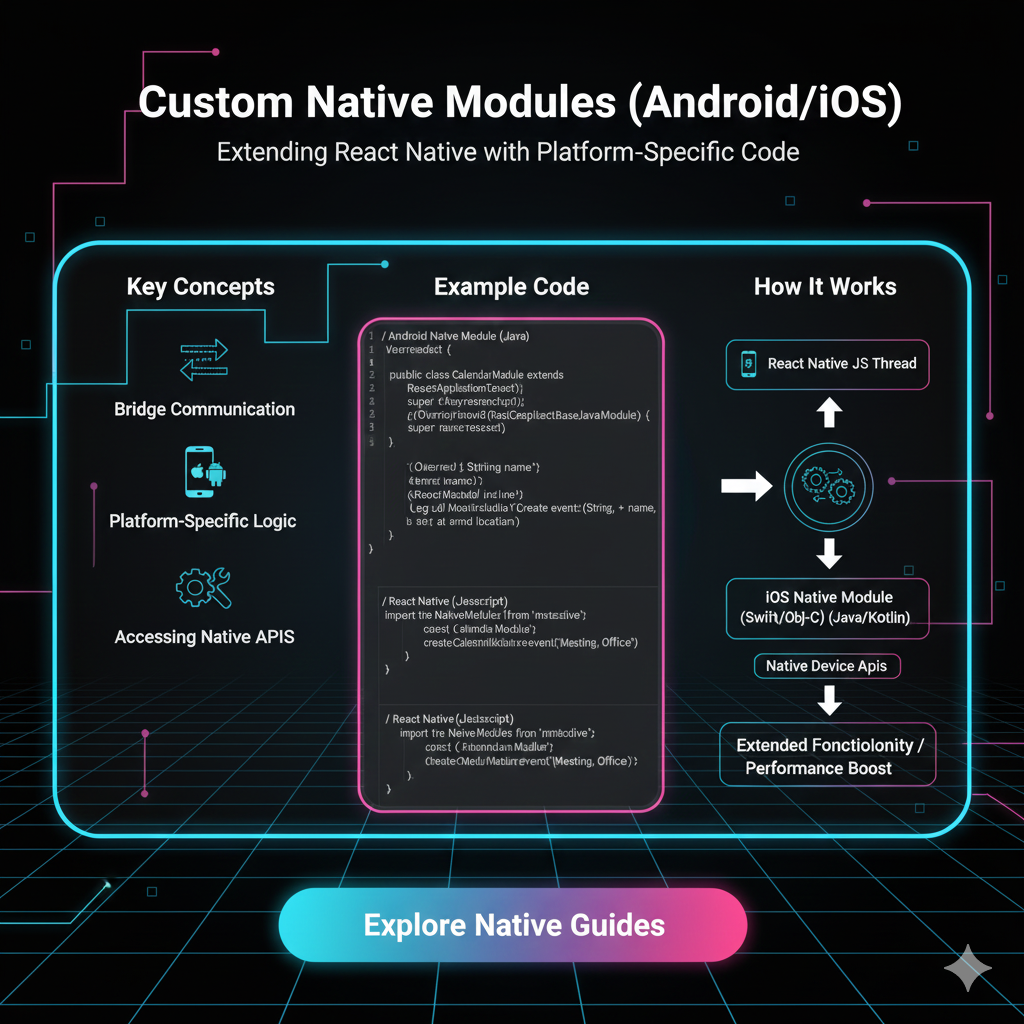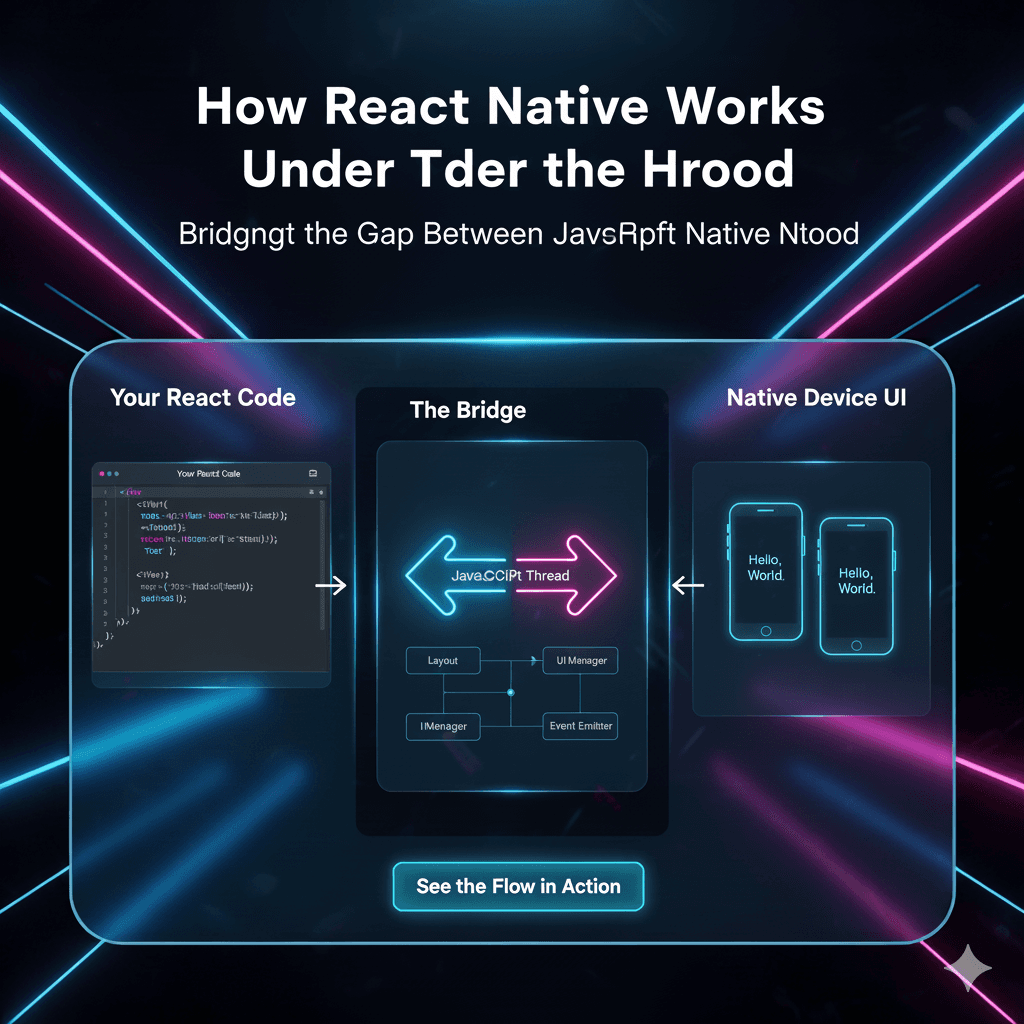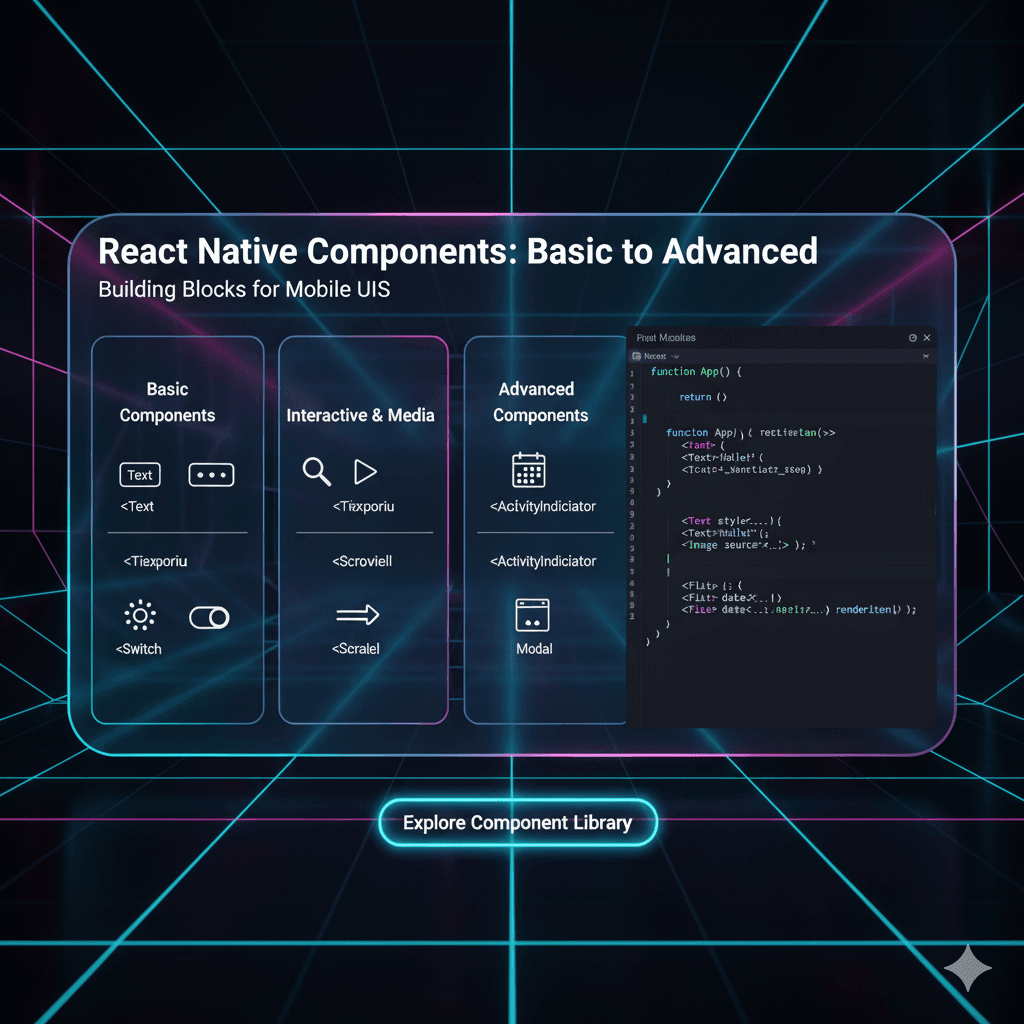Unlock Peak Performance: Your Ultimate Guide to Custom Native Modules (React Native)

Tired of React Native's limits? Master Custom Native Modules! Learn how to bridge the gap to native code for high-performance Android & iOS features. Level up your app dev skills.

Unlock Peak Performance: Your Ultimate Guide to Custom Native Modules (React Native)
Unlock Peak Performance: Your Ultimate Guide to Custom Native Modules
Alright, let's talk about something every React Native developer hits eventually: the wall.
You're cruising along, building your app with the magic of JavaScript and React. The hot reload is fire, the components are sleek, and life is good. Then, you get that one feature request. "Hey, can we integrate this custom fingerprint scanner?" or "We need to add this complex video processing filter." You dive into the docs, and... crickets. The community library is outdated, or worse, it doesn't exist.
This, my friends, is where the real magic happens. This is where you stop being a framework user and start being a true mobile developer. You're about to learn the secret sauce: Custom Native Modules.
So, What Exactly is a Native Module? (No Jargon, I Promise)
In simple terms, a Native Module is a piece of code—written in the native language of the platform (Java/Kotlin for Android, Objective-C/Swift for iOS)—that you can call directly from your JavaScript.
Think of it like this: Your React Native app is the CEO, speaking in JavaScript. The native parts of the phone (the camera, the Bluetooth, the file system) are the specialized departments, speaking in Kotlin or Swift. A Native Module is the bilingual executive assistant that translates the CEO's orders into instructions the departments understand, and then brings the results back.
It's a bridge. A bridge between the cross-platform world of JavaScript and the powerful, device-specific world of native code.
Why Bother? When Do You Actually Need One?
You don't need a Native Module to change a background color or navigate between screens. React Native has you covered for 90% of app features. But for that other 10%, native modules are your best friend.
Real-World Use Cases (The "Aha!" Moments):
Heavy Lifting & Performance: You're building a photo-editing app. Applying a complex, custom filter to a 4K image in JavaScript would be painfully slow. By writing that image processing logic in a Native Module (using C++ or highly optimized native code), you get buttery-smooth performance.
Accessing Unsupported Device Features: Maybe you need to interact with a specific hardware sensor, a special barcode scanner attached to a enterprise tablet, or control NFC in a way the standard library doesn't allow. Native modules give you the keys to the kingdom.
Using Existing Native Libraries: Your company has already invested years in building a brilliant, complex C++ library for data encryption. Instead of rewriting it in JavaScript, you can create a thin Native Module wrapper around it and use it directly in your React Native app. This is a massive time-saver.
Background Tasks: While JavaScript can handle some background logic, long-running tasks (like processing a large dataset or listening for location in the background) are far more reliable and efficient when handled on the native side.
Let's Get Our Hands Dirty: A Simple Example
Enough theory. Let's build a tiny "Hello World" module. We want to create a native function that we can call from JS, which returns the string "Hello from the Native Side!".
We'll look at the modern ways of doing this.
For Android (Kotlin)
First, you create a Kotlin class, let's call it HelloModule.kt.
kotlin
package com.yourapp // Your app's package name
import com.facebook.react.bridge.ReactContextBaseJavaModule
import com.facebook.react.bridge.ReactApplicationContext
import com.facebook.react.bridge.ReactMethod
import com.facebook.react.bridge.Promise
class HelloModule(reactContext: ReactApplicationContext) : ReactContextBaseJavaModule(reactContext) {
// This is the name JS will use to access this module
override fun getName() = "HelloModule"
// This annotation exposes the method to JavaScript
@ReactMethod
fun sayHello(promise: Promise) {
promise.resolve("Hello from the Native Side (Kotlin)!")
}
}Next, you need a Package to register this module.
kotlin
package com.yourapp
import com.facebook.react.ReactPackage
import com.facebook.react.bridge.NativeModule
import com.facebook.react.bridge.ReactApplicationContext
import com.facebook.react.uimanager.ViewManager
class HelloPackage : ReactPackage {
override fun createNativeModules(reactContext: ReactApplicationContext): List<NativeModule> =
listOf(HelloModule(reactContext))
override fun createViewManagers(reactContext: ReactApplicationContext): List<ViewManager<*, *>> =
emptyList()
}Finally, you add this package to your MainApplication.kt file.
For iOS (Swift)
On the iOS side, you'll create a Swift file, HelloModule.swift.
swift
import Foundation
import React
@objc(HelloModule)
class HelloModule: NSObject {
// Exposes this method to JavaScript
@objc
func sayHello(_ resolve: RCTPromiseResolveBlock, rejecter reject: RCTPromiseRejectBlock) -> Void {
resolve("Hello from the Native Side (Swift)!")
}
// Exposes the module itself
@objc
static func requiresMainQueueSetup() -> Bool {
return true
}
}The JavaScript Side
Now, back in your JavaScript/React code, you can call this native method.
javascript
import { NativeModules } from 'react-native';
const { HelloModule } = NativeModules;
// ... inside your component
const greetNative = async () => {
try {
const message = await HelloModule.sayHello();
console.log(message); // "Hello from the Native Side (Kotlin/Swift)!"
alert(message);
} catch (e) {
console.error(e);
}
};Boom! You've just established communication between two different universes. How cool is that?
Leveling Up: Best Practices You Can't Ignore
Building a simple module is one thing; building a good one is another.
Type Safety is Your Friend: Use
TurboModule(the modern, type-safe successor to the old bridge) for new projects. It requires a bit more setup with a codegen step, but it's faster and catches errors at compile time instead of runtime.Design the JS API First: Before writing a single line of native code, think about how you want to use it in JavaScript. Design a clean, promise-based, idiomatic JS interface. The native code should serve the JS, not the other way around.
Threading Matters: Remember, native modules run on their own threads. Don't block the main (UI) thread with long operations. And be careful when passing callbacks back to JS—they might not be on the thread you expect.
Error Handling is Non-Negotiable: Always use
Promisefor asynchronous methods. This gives you a cleanresolve/rejectpattern that JS developers are familiar with. Never let a native crash bubble up into a white screen of death in JS.Documentation is a Feature: Write clear documentation! What does the module do? What are the method signatures? What are the possible error codes? Your future self (and other developers) will thank you.
TurboModules & Fabric: The Future is Now
The React Native team is continuously improving the architecture. The old "bridge" was sometimes a performance bottleneck.
TurboModules: As mentioned, this is the new, leaner, and meaner system for native modules. It lazy-loads modules, making app startup faster, and provides better type safety.
Fabric: This is the new rendering system, which allows for synchronous communication between the native and JS threads for UI operations, making scrolling and animations feel more responsive.
If you're starting a new project today, it's highly recommended to align your native module development with these new architectures.
FAQs – Your Questions, Answered
Q1: Is it hard to learn?
It has a learning curve, for sure. You need to be comfortable with both JavaScript and at least one native mobile language (Kotlin/Java or Swift/Objective-C). But it's not rocket science. Start small, like the example above.
Q2: Can I write a module for both Android and iOS at once?
The module logic is platform-specific, but the JavaScript interface should be identical. You create the Android version in Kotlin, the iOS version in Swift, and then from your JS code, you call the same method name. React Native will automatically call the correct native implementation based on the platform.
Q3: Do I need to eject from Expo to use Native Modules?
Generally, yes. Expo is a fantastic tool that provides a curated set of native modules. But if you need to write your own custom one, you'll need to switch to the bare React Native workflow (what used to be called "ejecting"). EAS (Expo Application Services) is making this boundary much smoother, but you're still stepping into the native world.
Q4: How do I debug a Native Module?
You debug the native side using the native tools: Android Studio for Android (with breakpoints in your Kotlin code) and Xcode for iOS (with breakpoints in your Swift code). It's a different mindset from debugging JS in Chrome.
Conclusion: From Good to Great
Mastering Custom Native Modules is what separates competent React Native developers from the true experts. It transforms you from someone who can only use what's available into a developer who can build anything.
It empowers you to break through the limitations of the framework and tap directly into the immense power of the native platforms. You're no longer constrained; you are enabled.
The journey involves getting comfortable with native IDEs, understanding the build processes, and thinking in multiple languages. But the payoff is immense: the ability to deliver high-performance, feature-rich applications that feel truly at home on their respective platforms.









